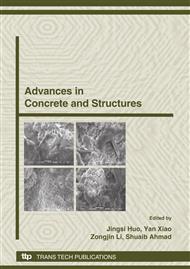p.881
p.887
p.893
p.901
p.911
p.917
p.923
p.929
p.935
Modeling Testing of Reinforced Concrete Block Masonry Structures
Abstract:
Integrated simple and complete model similarity theory of this structure are set up in this paper. Selection about model reinforced concrete block masonry materials is presented when simple similar model is adopted in testing. Correlations between model and prototype results in basic strength characteristics of masonry prism are reported based on theory analysis. This includes axial compression, joint shear for ungrouted prisms and grouted prisms. The model testing indicated that the structure adopting simple similarity model can accord with the prototype masonry prisms results. The monotonic shear testing of two-story model reinforced masonry shear wall in different compressive forces was performed. The testing results showed that the model structure can accord with the prototype masonry walls results. The shear bearing capacity of model structure is 0.94 times than that of prototype structure without axial compressive force. The shear bearing capacity of model wall is 1.08 times larger than that of prototype wall when the axial stress equal to 1.5 .Model testing and theory foundation adopting simple similar model is erected to carry out reinforced masonry structure.
Info:
Periodical:
Pages:
911-916
Citation:
Online since:
October 2008
Authors:
Keywords:
Price:
Сopyright:
© 2009 Trans Tech Publications Ltd. All Rights Reserved
Share:
Citation:


